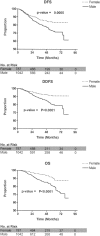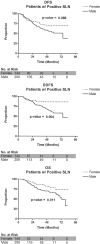Gender-related differences in outcome for melanoma patients
- PMID: 16633005
- PMCID: PMC1570554
- DOI: 10.1097/01.sla.0000216771.81362.6b
Gender-related differences in outcome for melanoma patients
Abstract
Objective: To better understand the factors associated with the well-established gender difference in survival for patients with melanoma.
Summary background data: Gender is an important factor in patients with cutaneous melanoma. Male patients have a worse outcome when compared with females. The reasons for this difference are poorly understood.
Methods: This prospective multi-institutional study included patients aged 18 to 70 years with melanomas > or =1.0 mm Breslow thickness. Wide excision and sentinel lymph node (SLN) biopsy was performed in all patients. Clinicopathologic factors, including gender, were assessed and correlated with disease-free survival (DFS), distant disease-free survival (DDFS), and overall survival (OS).
Results: A total of 3324 patients were included in the covariate analyses; 1829 patients had follow-up data available and were included in the survival analyses. Median follow-up was 30 months. On univariate analysis, men (n = 1906) were more likely than women to be older than 60 years (P < 0.0001), have thicker melanomas (P < 0.0001), have primary tumor regression (P = 0.0054), ulceration (P < 0.0001), and axial primary tumor location (P < 0.0001). On multivariate analysis, age (P = 0.0002), thickness (P < 0.0001), ulceration (P = 0.015), and location (P < 0.0001) remained significant in the model. There was no difference in the rate of SLN metastasis between men and women (P = 0.37) on multivariate analysis. When factors affecting survival were considered, the prognosis was worse for men as validated by lower DFS (P = 0.0005), DDFS (P < 0.0001), and OS (P < 0.0001).
Conclusions: Male gender is associated with a greater incidence of unfavorable primary tumor characteristics without an increased risk for nodal metastasis. Nonetheless, gender is an independent factor affecting survival.
Figures



References
-
- Balch CM, Soong SJ, Gershenwald JE, et al. Prognostic factors analysis of 17,600 melanoma patients: validation of the American Joint Committee on Cancer melanoma staging system. J Clin Oncol. 2001;19:3622–3634. - PubMed
-
- Gershenwald JE, Thompson W, Mansfield PF, et al. Multi-institutional melanoma lymphatic mapping experience: the prognostic value of sentinel lymph node status in 612 stage I or II melanoma patients. J Clin Oncol. 1999;17:976–983. - PubMed
-
- Gershenwald JE, Mansfield PF, Lee JE, et al. Role for lymphatic mapping and sentinel lymph node biopsy in patients with thick (> or = 4 mm) primary melanoma. Ann Surg Oncol. 2000;7:160–165. - PubMed
-
- Carlson GW, Murray DR, Hestley A, et al. Sentinel lymph node mapping for thick (> or = 4-mm) melanoma: should we be doing it? Ann Surg Oncol. 2003;10:408–415. - PubMed
Publication types
MeSH terms
LinkOut - more resources
Full Text Sources
Medical

